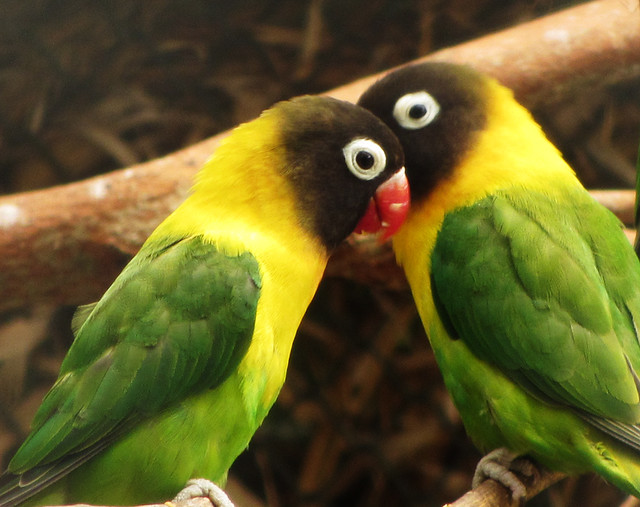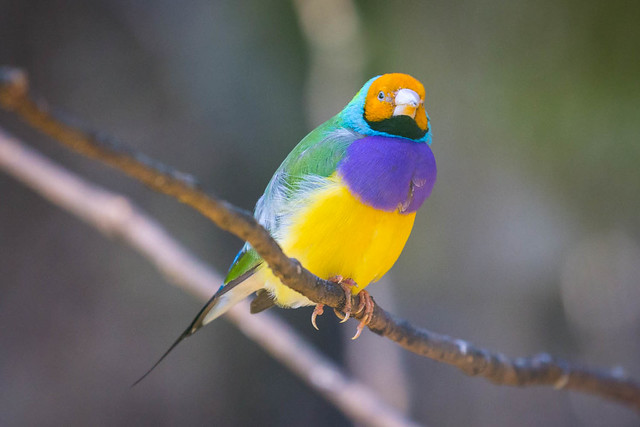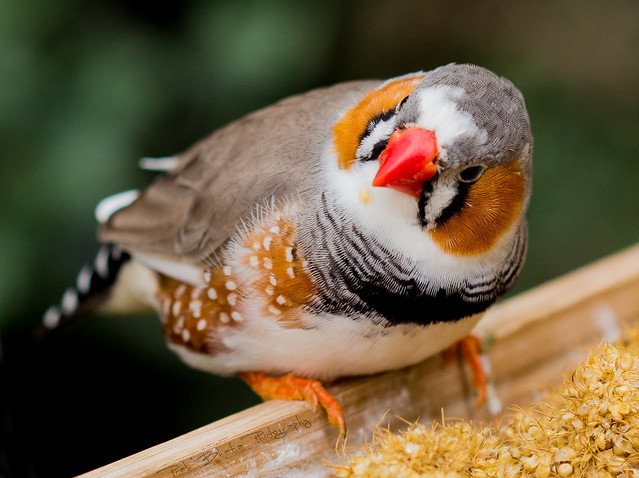(Original Title: GOULDIAN FINCHES - Nature's Brilliant Rainbows)
Introduction
The
Gouldian Finch is one of the most colorful species of birds in the world. Gouldians originate from the tropical region of northern Australia. In the late 19th century, Gouldian Finches, also known as Lady Gouldian Finches, were exported to Great Britain where they were enthusiastically received. In 1960, Australia prohibited the exportation of these birds.
Description
Gouldian's plumage appears almost artificially brilliant such that their coloration seems unnatural. As with many species of birds, the plumage of the male Gouldian is more striking than that of the female. Gouldian finches are one of the easiest birds to sex, as each gender has a distinct pattern of feather colors. Additionally, the center tail feather of the male is longer than that of the female.
Juveniles also have quite distinctive colors and are naked and pink until they are about 12 days old. Interestingly, the beaks of young Gouldians have a phosphorescent blue bead on either side that allows their parents to see them in the dark.
There are three naturally occurring varieties of Gouldians - the black-crested, the red-crested, and the yellow-crested. In addition to the commonly recognized color varieties, there are a number of color sub-variants including blue and yellow-bodied mutations.
Behavior
All finches are social and Gouldians are no exception. They should be housed in one or more pairs to keep them emotionally healthy. Gouldian finches require a higher level of care than that their more laid back and hardier cousins, the
Zebra Finch and
Society Finch.
All finches are diurnal, which means they are active in the daytime. Offer your pet birds at least 8 hours of exposure to sunlight to provide them with essential vitamin D. In warm weather, put the cage outside as a special treat. And like all finches, Gouldian finches resist finger-taming or petting.
Feeding
Lady Gouldian finches require more vitamins, nutrients, and supplements in captivity than heartier finch breeds such as the Zebra and Society Finches. Diet consists of varieties of seeds, live food, and rock salt.These birds also require a good amount of protein and calcium, especially in breeding season. Mealworms and eggs are a good source of protein and can be kept in a feeding cup separate from that of their seed bowl. A second separate cup can be kept containing greens like lettuce and celery. As with all finches, grit is not needed, but calcium-rich cuttlebone is a must.
Cages and Aviaries
Gouldian finches are around five inches in size, but they need twenty inches minimum of horizontal flying space. The spacing between bars should not be over 1/2 inch in order to thwart escape attempts and reduce the chance of injury. These birds are well suited for either metal or wooden cages. But do not house your finches in brass cages. Brass is toxic to finches!
All finches enjoy bathing, and if given the opportunity will bathe up to three times a day. Place a small open dish of water in the bottom of their cage to help the birds maintain their skin and feathers.
Gouldians need warmth. The ideal indoor temperature for these birds is 75 degrees Fahrenheit. Temperatures below 50 degrees Fahrenheit can cause serious illness and even death.
Health Issues
Unlike hardier species of finches, frequent stress to Gouldians can weaken their resistance to disease. These birds are creatures of habit. When change is forced upon them they will become stressed and anxious. For instance, frequent cage movement can be very disruptive to them.
Two of the most prevalent health problems with Gouldians are air sac mites and
Egg Binding.
Egg Binding is a serious problem that affects the female. Eggs get stuck in the birthing canal and the bird is unable to pass it. Symptoms include loss of appetite, weakness and sitting at the bottom of the cage. Egg Binding requires immediate attention.
Air sac mite infestation is a respiratory ailment that makes it difficult for the finch to properly breathe. This can lead to more serious illness and should be immediately treated by a veterinarian.
Streptococcus is another common finch disease. This illness is caused by a wound infection that did not heal properly. Symptoms of this disease include panting, listlessness, fluffing, weight loss and, in severe cases, seizures. Streptococcus is curable when treated at first at first sign of illness.
Breeding
Gouldian finches are somewhat difficult to breed and prefer a nest box placed in a breeding pair cage as opposed to nesting in their regular cage.
These birds breed and nest during the wintertime, so indoor heated housing is a must. As breeding season approaches, the tip of the male's beak will turn a bright cherry red. The pair produces four to six eggs during each mating cycle. One egg is laid per day.
Newly hatched chicks are pink and featherless until about 12 days old when the beginnings of feathers start to appear. Fledglings leave the nest at 3 weeks.
Female finches don't always stand by their man. Given the opportunity, they'll indulge in a promiscuous tryst with other males. This infidelity is not merely cold-hearted cheating. It's an evolutionary strategy that encourages dominant males to pass on their genes.
Conclusion
Gouldians have gorgeous plumage. Because of their brilliant feathers, they actually give the appearance of being artificial.
Though Gouldian Finches are officially listed as an endangered bird in Australia, they can be readily be purchased in Europe and North America. These birds are most comfortable in a stable housing environment with a minimum of cage movement to avoid stress.
It's recommended that prospective finch owners with little or no experience in finch care consider those hardier breeds such as the Society Finch or Zebra Finch over that of the Gouldian Finch.
Although the care of Gouldians is more involved than that of other finch species, enjoyment of their vibrant colors, quirky personalities, and bouncy energy makes a rewarding return on your investment in their welfare.
By Daniel P. Ransom
Daniel P. Ransom is a finch expert and enthusiast with over 20 years experience keeping and breeding many varieties of finches. He supplies local and regional pet shops and aviaries with healthy and happy finches.
Article Source: EzineArticles
|
















